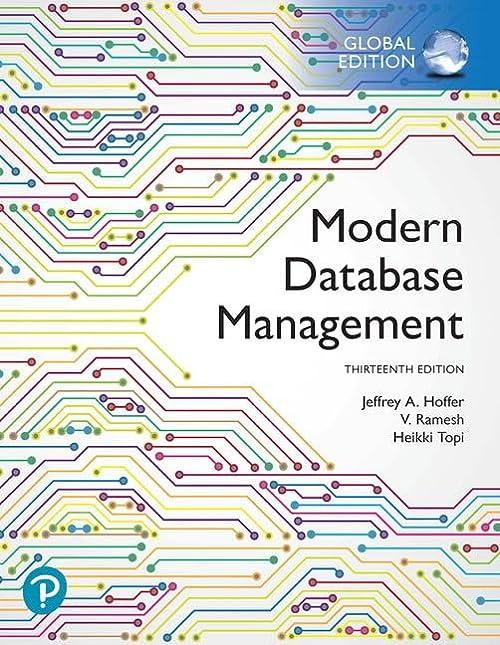Question
****Do not Copy From chegg answers **** I need help with this problem in of Database Extended entity relationship diagram Question: 1. An EER (extended
****Do not Copy From chegg answers ****
I need help with this problem in of Database Extended entity relationship diagram
Question: 1. An EER (extended entity-relationship) diagram for the domain described below 2. A list of relational schemas corresponding to the EER diagram you developed 3. A list of the assumptions you made in developing your EER diagram and the constraints that your model does not satisfy (if any), along with a short description of why these constraints are difficult to enforce
Description of the problem
1.1 Goal you are given a description of the requirements specification of the Purple Line Chemical Company (PLChem), a small chemical supply com- pany. From these specifications, you will need to demonstrate the methods we have described in the course thus far to develop an EER diagram repre- senting the model for the company.
2 Requirements Specification The critical values and relationships the company needs to store are described below. Note that these descriptions are not sufficient to fully establish all of the constraints you may need to enforce in the database, so you will need to make assumptions about relationships that are not specified. Also, your design may not be able to enforce all of the given requirements. You should make note of unfulfilled requirements and why they are not easily enforced.
1. Contact: an organization or individual with whom Purple Line does busi- ness. Each contact has an identifying name, as well as a phone number, email, and shipping address (street/city/state/zip). Contacts serve one of three roles: Customer: customers purchase finished products from Purple Line. Supplier: suppliers sell Purple Line the reagents and reactors necessary to produce products for Purple Lines customers. Shipper: shippers transport finished products from Purple Line to their customers. Purple Line keeps track of the shippers rates as well as whether their trucks are temperature controlled.
2. Employees: a person who works at Purple Line. Each employee has a unique employee ID, a name, salary, address, birth date, and phone number. Employees can be of the following kinds: Staff: employees who manage the other employees, sales, and finances at Purple Line. Each staff member has a job title. Technicians: technicians are the employees responsible for the creation and testing of the products made by Purple Line. For each technician, we store their highest degree earned and degree-granting institution. 3. Reagents: reagents represent the raw materials used to to create finished products. Each reagent is identified by an ID and a lot #, and they have a name, expiration date, quantity, pH, and density. 4. Reactors: reactors are the machines used to combine reagents into fin- ished products. Reactors have an identifying serial number, as well as a max volume, temperature, and number of turbines. 5. Product: products are the chemicals manufactured and sold by Purple Line. For every product, Purple Line records the name, price, pH, density, viscosity, and % water. Products are identified by an ID. 6. Batch: products are prepared in batches, identified by a lot #. Every batch also has an expiration date and a quantity. Purple Line does not maintain records for batches of discontinued products.
In addition, Purple Line is concerned with storing the following relationships: 1. Every batch of product is manufactured by a technician using a set of reagents in a reactor. Every product must be manufactured, but not all techs or reactors may have manufactured a product. The manufacture date is stored for every product batch.
2. Every batch is also quality-controlled by a technician, who may be different than the manufacturing tech. Quality control involves recording the pH, density, viscosity, and % water for a product batch.
3. Purple Line stores information about orders, which can be a shipment of raw materials from a supplier or a shipment of finished products. Both kinds of orders have a unique identifier, a ship date, a delivery date, and 2 a tracking number.
Supplier orders store the supplier fulfilling the order, the staff member who placed the order, the reactors and/or reagent lots being ordered, and the total cost. Customer orders store the customer who placed the order, the shipper who fulfills the order, the lots of products being ordered, and the packaging costs for the order.
4. All orders will have at least one reagent, reactor, or product, but may have several. The same product may be ordered multiple times, but a particular lot # or reactor may only be ordered once. Customers and suppliers may make multiple orders or none at all.
Step by Step Solution
There are 3 Steps involved in it
Step: 1

Get Instant Access to Expert-Tailored Solutions
See step-by-step solutions with expert insights and AI powered tools for academic success
Step: 2

Step: 3

Ace Your Homework with AI
Get the answers you need in no time with our AI-driven, step-by-step assistance
Get Started


